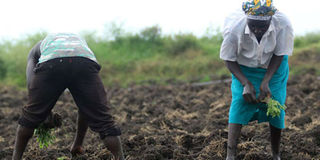Vibrant EAC cross-border trade critical to region’s food security

Farmers in Ahero Irrigation Scheme, Kisumu County, plant tomatoes on November 14, 2017. The government’s strategy of producing food under irrigation would reduce dependency on rain-fed agriculture. PHOTO | TONNY OMONDI | NATION MEDIA GROUP
What you need to know:
- The biggest challenge for Kenya is to increase and stabilise output to meet national demand and even build a surplus for export.
- The lesson for Kenya is to integrate better farming practices to increase its yield in the medium to long-term.
The commitment by President Uhuru Kenyatta and his Tanzanian counterpart, Mr John Pombe Magufuli, to have trade and bilateral issues between the two countries resolved is an important step towards enhancing the free movement of goods and services in the East African Community (EAC).
Even though the presidents described the recent cross-border hostilities as small differences, traders and investors have been worried about their future stake in the regional market.
Resolving the dispute, which restricted the movement of goods, livestock and people across the common border, is critical to deepening trade and exchange among the six EAC countries.
Kenya and Tanzania, being the two largest economies, should ideally be driving the EAC integration that includes Uganda, Rwanda, Burundi and South Sudan.
FOOD SECURITY
Kenya and Tanzania need each other in many key areas.
One is food security — which is on President Kenyatta’s ‘Big Four’ agenda to transform the economy in the next five years.
Kenya is a food deficit country, as 80 per cent of its land is arid and semi-arid and frequent, prolonged droughts, have increased its dependency on food imports.
Tanzania is better endowed, with large tracts of arable land and a fairly good weather.
It is least affected by the recurrent Horn of Africa drought that mainly hits Kenya, South Sudan, Somalia and Ethiopia.
The latest Famine Early Warning System (Fews) network report shows Tanzania has minimal food challenges — except for areas occupied by refugees on the Burundi border.
FOOD PRODUCTION
Food production data shows Tanzania’s output increasing remarkably, which makes it an important buffer for stabilising Kenya’s food supply and prices.
Tanzania’s production of cereals (mainly maize, wheat and rice) nearly doubled from 5.4 million tonnes in 1995 to more than 10 million tonnes, the latest reports by the United Nation’s Food and Agriculture Organisation (FAO) show.
Over the same period, Kenya’s output increased from 3.6 million tonnes to 3.9 million tonnes amid wide fluctuations depending on weather variability.
This illustrates the difficulty for it to sustain output and satisfy local demand.
Notably, Uganda, also an important source of maize for Kenyans, nearly doubled its output from 1.9 million tonnes to 3.5 million tonnes.
With a steady growth trade, Uganda has caught up with Kenya — whose production stagnated.
IRRIGATION
There could be other factors driving these trends — such as the supply of inputs and extension services.
But, presumably, Tanzania and Uganda are doing better in this respect because their yields per hectare rose more significantly than Kenya’s.
The biggest challenge for Kenya is to increase and stabilise output to meet national demand and even build a surplus for export.
The government’s strategy of producing food under irrigation would reduce dependency on rain-fed agriculture.
This would be achievable in the medium to long-term, when several dams in the marginal agricultural and pastoral areas will have been built.
Until then, Tanzania and Uganda will remain important for stabilising Kenya’s staple food needs.
FARMING PRACTICES
The President’s food security agenda also needs to focus on increasing cereals yields.
The FAO statistics show that while the yield in the EAC is, on average, two tonnes per hectare, South Africa has double that.
The top cereals producer, the United States, averages eight tonnes and China, with a phenomenal output growth over the decade to become the second-largest producer, has six tonnes.
The lesson for Kenya is to integrate better farming practices to increase its yield in the medium to long-term.
Mr Warutere is a director of Mashariki Communications Ltd. [email protected]





